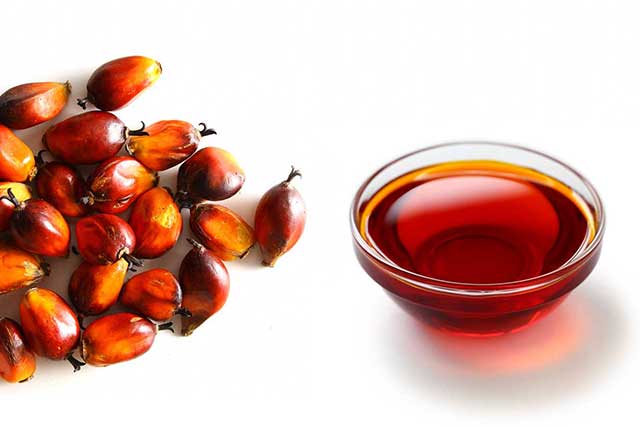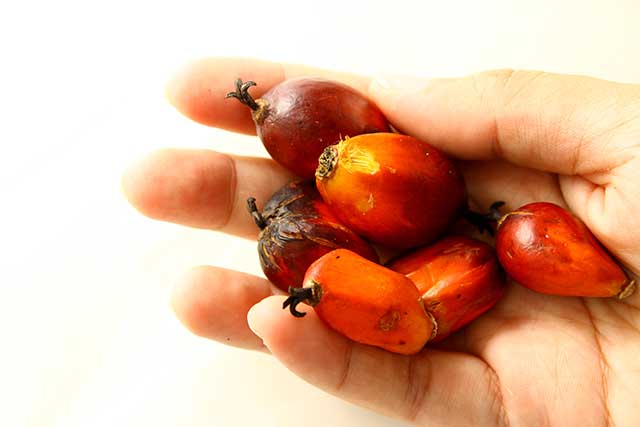Red palm oil is a unique cooking fat with some interesting nutrition properties.
This article provides a guide to the tropical fat, its nutrition benefits, and potential drawbacks.
How does it compare to other choices of cooking fat and is it a healthy choice?
What Is Red Palm Oil?

Red palm oil is a tropical oil that comes from the pulp of palm fruit. These fruits grow on palm trees located in Africa, the Americas, and South-East Asia.
The first thing people notice about red palm oil is the trademark orangey red color which comes from the palm fruit’s high carotenoid content.
Interestingly, red palm oil also has a long history, and historical records date back to the year 3000 BC in ancient Egypt (1).
Unlike its refined palm oil relatives, red palm oil is typically cold-pressed and unrefined.
Nutritionally, red palm oil offers an interesting nutrient profile, and it contains a variety of carotenoids and antioxidants.
However, harvesting oil from palm trees is controversial due to environmental concerns such as deforestation and loss of animal habitats.
In this article, we will take a deeper look into each of these issues.
Nutrition Facts
The following data table shows the nutritional values for one tablespoon of red palm oil (1).
| Calories/Nutrient | Amount (kcal/grams) |
|---|---|
| Calories | 130 kcal |
| Carbohydrate | 0 g |
| Fat | 14.0 g |
| – Saturated Fat | 6.0 g |
| – Monounsaturated Fat | 6.0 g |
| – Polyunsaturated Fat | 1.5 g |
| Protein | 0 g |
Benefits of Red Palm Oil
Red palm oil offers several benefits due to its unique composition and nutrition properties.
1) Rich In Vitamin E
Red palm oil contains 2.17 mg of vitamin E per tablespoon serving, which is approximately 11% of the RDI (2).
The composition of vitamin E in red palm oil is as below (3);
- Alpha-tocopherol: 19%
- Alpha-tocotrienol: 29%
- Gamma-tocotrienol: 41%
- Delta-tocotrienol: 10%
Alpha-tocopherol is considered to be the most important of these compounds because it has the best bioavailability (4).
Vitamin E is an antioxidant that protects lipids from oxidizing, which may help to keep red palm oil fresh (5, 6).
Additionally, vitamin E has benefits for human health too, and research shows that it can enhance the immune system (7).
2) Red Palm Oil Is a Significant Source of Carotenoids
Salmon and carrots both have an orange color due to the carotenoids they contain.
It is the same thing with red palm oil; the high carotenoid concentrations of the oil are behind the dark orange/red color.
Per tablespoon, red palm oil provides 200 RAE (retinol activity equivalents) of vitamin A, which is equivalent to 22% of the RDI (1).
This concentration of vitamin A in just one tablespoon is a significant amount; two tablespoons of red palm oil per day would provide nearly 50% of the RDI.
Vitamin A has numerous health benefits, and it is particularly important for immune health and vision (8).
3) Red Palm Oil Is Cold-Pressed

The vast majority of vegetable oils are ultra-processed. In other words; refined, bleached, and deodorized.
However, some oils, most famously extra virgin olive oil, are cold-pressed.
Cold-pressing is a gentler processing method that preserves more of the oil’s natural compounds, such as antioxidants (9).
The majority of food manufacturers use refined palm oil in their products.
In contrast, red palm oil is a cold-pressed and unrefined fat.
We can see this because the oil retains its red hue from the pulp of the palm fruit, whereas refined palm oil is colorless.
For those that prefer to use less processed oils, cold-pressed products like red palm oil may be preferable.
4) Red Palm Oil Is Heat-Stable At High Temperatures
The oxidative stability of cooking fat is very important.
For example, using a heat-stable fat means the oil is less likely to break down and create oxidation products such as polar compounds (10, 11).
Saturated fats are the most heat-stable type of fat. Since the carbon atoms in these fats are fully “saturated” with hydrogen atoms, they are strongly resistant to oxidation. In contrast, polyunsaturated fats are the most unsaturated and thus least resistant to oxidation (12).
On this note, red palm oil is approximately 44.5% saturated fat, 44.5% monounsaturated fat, and only around 11% polyunsaturated fats.
Monounsaturated fat is also relatively resistant to oxidation, which makes red palm oil a stable cooking fat.
Additionally, a range of studies shows that red palm oil is “reasonably stable to heat without any adverse effects” (13).
As a result, red palm oil is a good choice of cooking fat for use at high temperatures.
5) Provides a Large Source of Coenzyme Q10 (Ubiquinone)
Red palm oil is a good source of a compound called coenzyme Q10 (CoQ10).
Firstly, CoQ10 is an antioxidant that our body naturally produces, but we can also get it from exogenous (external) sources (14).
Red palm oil contains significant concentrations of CoQ10, and a tablespoon serving offer 400 mg of this compound (15).
Among the benefits that CoQ10 offers, research suggests that the compound is important for (16);
- Preventing the generation of free radicals
- Protecting DNA from oxidative damage
- Strengthening the immune system
- Improving energy production
Furthermore, a recent randomized controlled trial found that a daily dose (300 mg) of CoQ10 for 12 weeks “significantly decreased” inflammatory markers (p = <0.01) in liver cancer patients (17).
Another randomized clinical trial demonstrated that a 100-mg daily dose of CoQ10 “significantly decreased” oxidative stress in rheumatoid arthritis patients (18).
6) Red Palm Oil Contains Squalene
Squalene is a further interesting compound that red palm oil contains.
Some epidemiological and animal studies have suggested that squalene may have anti-cancer and anti-aging properties (19).
Extra virgin olive oil is one of the most significant dietary sources of squalene.
On this note, one hypothesis suggests that squalene may be a “major factor in the cancer risk-reducing effect of olive oil” (20).
Squalene may also act as a free radical scavenger, which means it could potentially help to reduce levels of oxidative stress (21).
However, there is a lack of clinical trials in humans to verify these potential benefits.
It is difficult to find the precise squalene content for red palm oil, but research shows that refined palm oil contains between 250 mg and 540 mg of squalene per liter (3.75 mg to 8.1 mg per tablespoon) (22).
It is possible that unrefined red palm oil contains larger concentrations than refined palm.
Concerns and Potential Drawbacks

Red palm oil is a healthy choice of cooking fat.
However, there are some concerns and potential drawbacks to using the oil.
1) Impact On Deforestation and Loss of Natural Habitats
Unfortunately, the palm oil industry has been responsible for the deforestation of large areas of rainforest (23, 24).
Sadly, this deforestation has caused the loss of animal habitats around the world.
Primates are one of the worst affected species, and this is particularly true for the critically endangered orangutans of Borneo (25, 26).
For those with concern for the environment, opting for certified sustainable red palm oil is said to help reduce the environmental impact (27).
However, a recent study investigated the effectiveness of certified sustainable palm oil plantations in comparison to non-certified plantations.
Regrettably, the study found “no significant difference between certified and non-certified plantations for any of the sustainability metrics investigated” (28).
Is Choosing Palm Oil a Poor Choice For the Environment?
As a non-expert in the environment/sustainability, I cannot comment on the complexities of this topic in-depth.
However, it is worth noting that palm oil is the world’s most produced edible oil, and simply replacing it would be a tricky proposition.
For instance, boycotting palm oil and replacing it with other vegetable oils would result in environmental damage as significant amounts of land would need to be cleared to make room for the new crops.
2) Overpowering Taste
Red palm oil has a powerful flavor, and it influences any food that you use it alongside.
People often say this cooking fat has a carrot-like flavor, but it has its own taste.
From experience, cooking eggs in red palm oil will make them taste like red palm oil eggs.
If you enjoy the flavor of red palm oil, then this could be a big positive point.
That said, many people prefer oils that don’t overly influence the natural flavor of their food.
3) Red Palm Oil Can Stain
Similar to the strong flavor it imparts, red palm oil also has a very strong color.
If you make fried eggs with the oil, their “white” part will turn orange.
The oil can stain both skin and clothes too, and while we can wash it off our hands, getting the stains out of clothes could be difficult.
For this reason, it may not be a suitable oil for those that have younger children around.
Final Thoughts
Overall, red palm oil has some interesting nutrition properties, and it appears to be one of the healthier oils for cooking.
However, environmental concerns about the oil are warranted, and much needs to be done to make the oil genuinely sustainable.
With a strong flavor profile, personal taste may dictate whether you enjoy using this oil or not.
For more on cooking fats, see this review of beef tallow.

Good article. But you are a little nuts about the flavor. I use it in my omelettes and love it. I do not think that it takes over, and I use Nutiva. I even use it in my oatmeal and cannot tell it is there by taste. You’re scaring people for nothing! It is not that heavy an oil either. I bet I could use it in a shake and not know it. Thanks for the good article. I only wish I knew where it was available now–can’t seem to find it in stock anywhere.
I guess we are all different! I’ve heard many say the same as you, and a few the same as me. Anyway – if you like or don’t notice the taste – that’s a good thing!